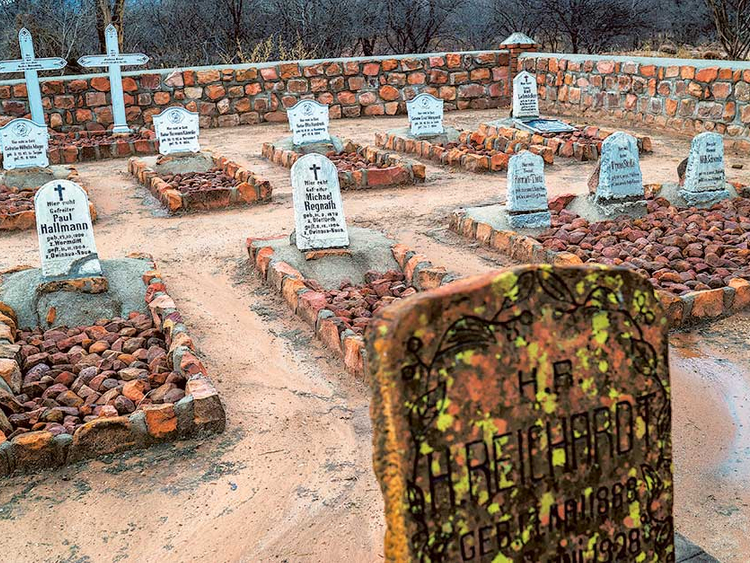
SWAKOPMUND, Namibia
The statue, depicting a German marine holding a rifle in his hands and standing guard over a dying comrade, has stood undisturbed for decades in the most prominent spot in Swakopmund, a city on Namibia’s coast.
It has survived the end of colonial rule in this corner of southern Africa, the subsequent occupation by apartheid South Africa, independence in 1990 and the present government by the black majority.
But a few months ago protesters spilled red paint over the monument, which stands in front of a colonial building that is now known as the State House and serves as the summer residence of Namibia’s president.
The statue, known as the Marine Denkmal, was erected in 1908 to commemorate soldiers who helped crush a rebellion against German colonial rule by the Herero and Nama ethnic groups, a war that led to what Germany’s current government is close to recognising as a genocide.
“They can take it to Germany, or they can take it to a museum,” said Uahimisa Kaapehi, an ethnic Herero city councilor who introduced a motion for the monument’s removal.
“We as Hereros and we as Namibians don’t want German soldiers in front of our State House.”
The push for the removal comes as the governments of Germany and Namibia are engaging in negotiations to close one of the grimmest chapters in Africa’s colonial history, the genocide of tens of thousands of Herero and Nama between 1904 and 1908. After decades of denial, German officials say they are ready to acknowledge the genocide formally, issue an apology and offer compensation.
German reticence is not the only reason the reckoning has taken so long. Namibia’s complicated internal dynamics have contributed as well. The Herero and Nama are minorities in a nation led since independence by the liberation party, the South West Africa People’s Organisation, or SWAPO, which is dominated by the Ovambo ethnic group. If SWAPO has historically shown little interest in highlighting the colonial-era genocide, Namibia’s tiny but economically powerful German-speaking minority has shown strong resistance.
A desert city facing the Atlantic, Swakopmund is the centre of Namibia’s German-speaking minority. It has what is perhaps the best collection of well-preserved colonial buildings in Africa, as well as a Bismarck Street and other thoroughfares named after German figures. Menus in hotels and restaurants are in German, catering to Namibia’s German minority as well as to German tourists.
Wilfried Groenewald, the single German-speaking person on Swakopmund’s 10-member City Council, said removing the monument would hurt the city’s economy.
“It’s essential for our tourism industry,” he said. “People come here to see this.”
Germany ruled Namibia, then known as South-West Africa, from 1884 to 1915. Alone among Germany’s African colonies, it attracted thousands of settlers, who grabbed land from locals. Between 1904 and 1908, the Herero and Nama launched the biggest - and last - rebellion against the Germans.
Groenewald argued that the Germans alone were not to blame for the cruelty of the war between 1904 and 1908.
“The conflict, of course, was there,’’ Groenewald said. “But who started the war? Was it Hereros who killed the German settlers? There was a past from all sides. Everybody had a bad side.”
Little German
Only 1 per-cent of Namibian households speak German as a main language, according to a 2011 census. But Namibians of German descent make up a tightly knit, economically powerful group, with their own schools and a daily newspaper.
Since independence they, like other white Namibians, have experienced a shrinking of their once outsize role in the country. Politically, they have been marginalized; economically, their dominance has been eroded by new groups, ranging from a new black elite to Chinese businessmen.
“Our children are leaving Namibia,” Groenewald said.
The threat to remove the monument speaks to the community’s fear of impermanence in Namibia, said Elke Zuern, a politics professor at Sarah Lawrence College in Bronxville, New York, who has done research on the meaning of Namibia’s national monuments.
Zuern said the German-Namibian community was stuck in the past. Unlike Germans, who have slowly come to terms with their colonial past, many German-Namibians reflexively seek to defend the era, minimize its harmful legacy or even deny the genocide, she said. In public - and even more so in community meetings held in German - some German-Namibians still express the kind of racist views that would be unthinkable in South Africa or other neighboring countries, Zuern said.
Laidlaw Peringanda, the leading activist against the marine statue, said the open glorification of soldiers responsible for the massacres of his Herero ancestors had irritated him for years. “But I just kept silent because our founding president talked about national reconciliation,” he said, referring to Sam Nujoma.
But he changed his mind after an incident last year that he and other Hereros regarded as an insult to their culture. In their section of the municipal cemetery, the Herero, traditional cattle herders, exhibited the horns of a cow belonging to their late paramount chief - drawing complaints, presumably from people tending to the cemetery’s German section. The City Council eventually ordered the horns removed, angering many Hereros.
As for the marine statue, which has two German-language plaques explaining that the colony’s soldiers fought for the “Kaiser and empire,” and was declared a national monument in 1969, the council has referred the matter to the National Heritage Council.
Kaapehi, the councilor pressing for the removal, acknowledged that it was a difficult fight. Like many Hereros, he believes that SWAPO, which controls the City Council and dominates the rest of the country, is interested only in a narrative that promotes it as the liberator of blacks from white-minority rule. Any reminder of the Herero and Nama resistance to German rule diminishes the SWAPO-centric national founding myth, he said.
— New York Times News Service













